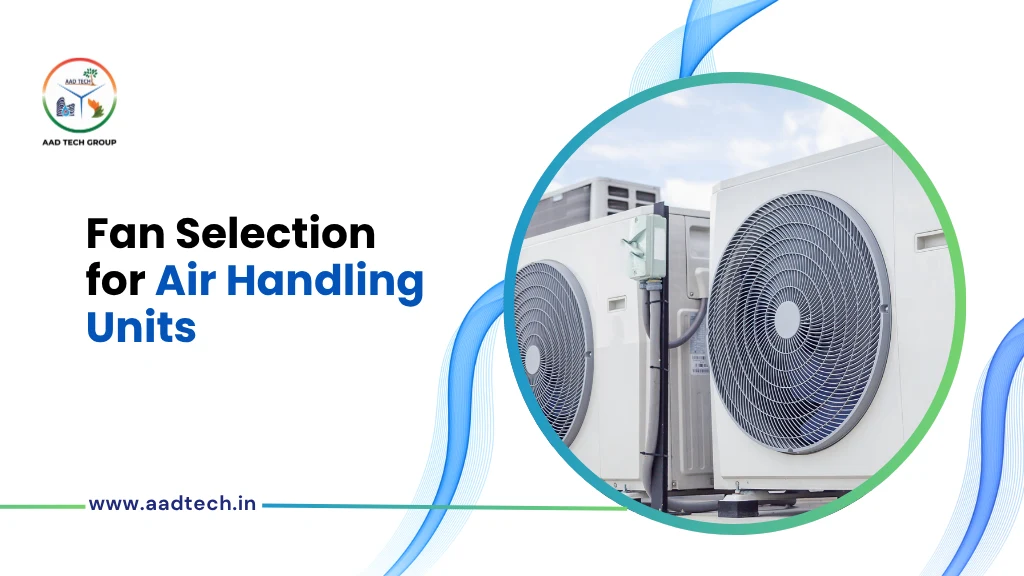How Important It Is For Designing The Air Conditioning Of An Area
One of the most important yet commonly overlooked decisions when designing a good air conditioning system, particularly in commercial or industrial buildings of large size, is the choice of the proper fan for the Air Handling Unit (AHU). The fan is the core of the AHU, it pushes air, affects energy usage, and has a direct influence over indoor air quality and thermal comfort within a space.
Airpac Cleantech, a part of AAD Tech Group, an expert in HVAC solutions, stresses how proper fan optimization at the time of upgrading or original installation of an AHU can greatly benefit system performance, save operational costs, and provide long-term reliability. Whether you are planning a system for a hospital, manufacturing facility, cleanroom, or commercial building, making the right fan selection is crucial in terms of efficiency as well as user comfort.
Recognizing the Function of the Fan within an AHU
The AHU maintains the flow of air, regulates temperature and humidity, and ensures air quality. Central to this function is the fan, which drives conditioned air through ducts and releases it across the defined zones uniformly.
A poor selection would lead to inadequate airflow, high noise levels, higher power consumption, and even a breakdown in the long run. On the other hand, the proper fan guarantees that the AHU maintains its best possible performance under changing load conditions while consuming the least amount of energy.
Important Factors to Consider While Choosing AHU Fans
1. Static Pressure and Air Volume Requirements
- The necessary airflow expressed in CFM (Cubic Feet per Minute) and total static pressure are the basic inputs in the selection of fans. These vary with the area size, application type (e.g., healthcare, data center, manufacturing), and resistance from filters, coils, ducts, and diffusers.
- A fan should be able to supply the required air volume at the system’s total resistance. Using an undersized fan may result in inadequate ventilation and temperature control, and an oversized fan can result in energy waste with added noise and vibration.
2. Energy Efficiency
- Newer HVAC systems take energy conservation into consideration. Fans consume most of the energy in any AHU. Equipping fans with energy-efficient motors like EC (Electronically Commutated) motors can significantly reduce power consumption.
- When upgrading an AHU, replacing older belt-driven fans with direct-drive EC fans or backward-curved centrifugal fans can result in significant energy savings and improved performance.
3. Noise Control
- Fan noise can be a real problem, particularly in hospitals, offices, or schools where acoustic comfort is paramount. The design of the fan, its blade shape, speed, and housing all have a bearing on the resulting noise levels.
- The use of low-noise fans, in conjunction with vibration isolators and sound attenuators, is necessary for applications where quietness is an absolute requirement.
4. System Layout and Space Constraints
- The layout of the mechanical room or ceiling space may also be a critical factor in selecting a fan. Even more so in retrofit applications, limited space can circumscribe the use of some fan types. In such cases, compact direct drive plug fans are normally a perfect fit, as they offer flexibility without losing performance.
- Airpac Cleantech, a part of AAD Tech Group, is known to produce tailored AHU solutions that consider available space, ducting complexity, and site-specific constraints to integrate fluidly.
5. Maintenance and Reliability
- Reliability of fans is essential to keep downtime and maintenance to a minimum. Direct-drive fans with fewer moving parts tend to be more reliable and easier to service than belt-driven systems.
- Selection of fans from reputable suppliers and inclusion of condition-monitoring systems can also lower the overall cost of ownership.
How Selection Impacts the Overall HVAC Design
Aside from energy and airflow, fan selection influences the overall design of the HVAC system, such as duct size, filter efficiency, and control strategy. Accurate fan selection ensures balanced airflow, minimizes stress on other components, and provides consistent indoor climate control.
In critical environments like operating theaters or cleanrooms, precision in airflow is crucial. In such applications, high-performance fans with strict tolerance are necessary to ensure compliance with industry standards and preserve sterility.
The Aad Tech Method
The firm uses leading-edge simulation tools, site visits, and best practices of the industry to suggest fan arrangements for maximum performance and lowest energy and maintenance expenses.
Whether you are looking to design a new system or replace an existing AHU, Aad Tech’s fan selection skills can be the key to a great HVAC system from a good one.
Conclusion
Fan selection for air handling units is not merely a mechanical decision; it’s a strategic one that impacts every aspect of an HVAC system. From comfort and efficiency to long-term operational effectiveness, the fan is the turning point. By associating with experts such as Airpac Cleantech, a part of AAD Tech Group, and concentrating on intelligent AHU upgrades, companies can guarantee their air conditioning systems provide outstanding performance all year round.AHU upgrades, companies can guarantee their air conditioning systems provide outstanding performance all year round.

